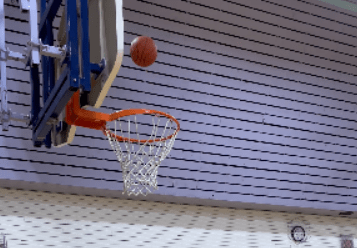Evaluating
Sources of Uncertainty
-Inaccurate measurement of peak height. It is a bit difficult to measure straight up into the air because there are the problems of measuring tapes not being able to stay completely straight while that high in the air.
-Time to reach basketball hoop and to reach peak height. I recorded this on my phone and I tried going frame by frame. Unfortunately, iPhone doesn’t show milliseconds in the gallery so the time shown in the data collection is very approximate and is my best guess based on how long I think it took in the video. The answer may not be exactly what it is supposed to be but is for sure close.
-Angle of the video recorded. The reason the perspective was so weird was because I was at a recreation center with other people playing as well. I didn’t want to record other people without their permission so that was the only angle I could get without getting anyone else in it. This is a limitation because while using this video in the video analysis program, it seems quite odd how the ball goes straight up then straight down (what it looked like in the video).
Ways To Improve the Experiment
This experiment has a few things that could’ve been improved to make this experiment even more accurate.
One way to improve this experiment is to have a recording device that allows you to see frame by frame and displays milliseconds when needed. This would’ve given a more accurate answer to the time data in this experiment.
Another way to improve this experiment is to have a better way of measuring peak heights. While this was somewhat accurate, a measuring tape at a high height becomes flimsy and hard to control. This made it a bit difficult to find the most accurate answer. To improve this, I think it would be easier to have something that isn’t as flimsy as measuring tape so that it is able to go up in a straight line rather than falling sideways and giving an inaccurate answer.
Ways a Scientist Could Improve my Experiment
A way a scientist could improve my experiment is having devices that directly track the velocity change the ball goes through while it makes its way to the net. This would make the experiment so much easier rather than having to go through different programs. Another way to improve this is to have a device that shows accurate measurements rather than having to manually measure heights with a measuring tape.
Application of the Experiment
If this experiment was better done by a scientist with an unlimited budget, this could help people by allowing them to understand how much force needs to be applied to the basketball to allow them to make a good shot. This will vary based on person but doing this gives people a rough idea on the basics of what needs to be done to help them succeed in basketball shooting.
NEW Data using Video Analysis
Ball starts 0.538 meters off the ground
Time to reach peak height (1.35 seconds)
Peak height (3.11 meters)
Time to reach net (2.02 seconds)
–Hoop measurement (116.4 inches) or (2.96 meters)
–Basketball weight (1.2 pounds) or (0.540 kilograms)
–Person distance from hoop (120 inches) or (3.0 meters)
-Initial Velocity (0 m/s)
Calculations

Different points during the Experiment

Start of shot

Peak height

End of shot
Conclusion
Question: How much force is needed to allow a basketball to travel the distance towards a basketball hoop? And does it vary based on person?
The answer to this question varies on a variety of different factors. First, there is no right answer to this question because it depends on the person. My experiment had the shot taken from 3.0 meters away from the hoop meaning that I didn’t have to apply a lot of force as I would if I were further away but also had to apply quite a bit to allow the ball to travel the distance needed.
The results of my experiment showed that for myself, from 3.0 meters away, I needed to apply a force of 5.1N to allow the basketball to travel towards the net.